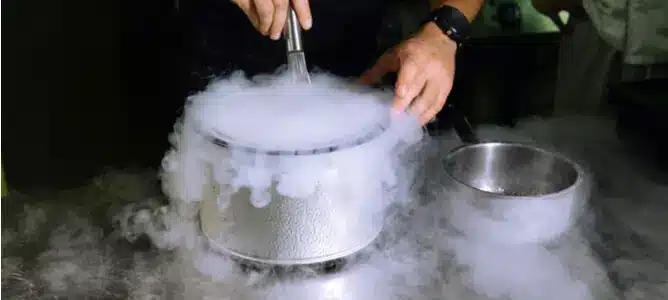The food industry continually seeks methods to extend the shelf life and maintain the quality of food products. One such method involves the use of nitrogen gas for food preservation, which is instrumental in the packaging process. Nitrogen gas serves as a preservative because of its inert properties and capacity to displace oxygen, a known catalyst for the oxidative deterioration of fresh food.
The Necessity for Controlled Atmospheric Packaging
Preserving the freshness, flavour, texture, and nutritional value of food is paramount within the food industry. Controlled atmospheric packaging (CAP) has shown significant promise, and its core component—nitrogen gas—plays a vital role. By replacing oxygen within the packaging, the growth of aerobic microorganisms and the speed of oxidation are both reduced, contributing to prolonged shelf life and enhanced quality.
Nitrogen Gas: The Inert Advantage
Nitrogen gas is predominantly favoured for its inertness. It is colourless, odourless, and non-reactive under most conditions, which means it does not alter the taste or appearance of the food product. The presence of nitrogen within food packaging creates a stable environment, repelling moisture and potential contaminants.
Applications in Various Food Industries
The application of nitrogen extends across various sectors within the food industry. Snack manufacturing companies use nitrogen flushing to preserve the crunchiness and flavour of chips in their packaging. It is equally effective in the preservation of dairy products, coffee, and fresh-cut produce, which require stringent measures to maintain quality and enhance longevity.
Leveraging Nitrogen Gas for Packaging Efficiency
Efficiency in food packaging is not solely about maximising shelf life; it’s also about ensuring that the food products remain presentable and undamaged during transport and storage. Nitrogen gas is used to provide a cushioning effect in packaging that helps prevent the content from shifting and getting crushed.
Advancements in Food Packaging Technology
As technology advances, the use of nitrogen in food packaging adopts new methods and equipment that make the process more efficient and environmentally friendly. Innovative packaging machines with precise nitrogen dosing capabilities ensure that the correct amount of gas is used, negating waste and further preserving the integrity of the food items.
Complementing Industrial Gases in Food Packaging
While nitrogen gas is prominent in food preservation, other industrial gases are also used in packaging applications to address specific needs. For example, a laser gas may be used to create precise cuts in packaging materials, facilitating customisable and efficient packaging solutions.
Optimising Gas Usage in Preservation Techniques
To ensure optimal preservation and safety, selecting the correct concentration and mixture of gases, such as nitrogen, is critical in food packaging. Therefore, the food industry collaborates with gas suppliers to find the most effective solutions tailored for each specific product.
Enhancing Sustainability in Food Packaging
The role of nitrogen extends beyond just preservation—it’s also a key player in developing sustainable packaging solutions. By reducing food wastage through extended shelf life, nitrogen usage in packaging supports sustainability initiatives within the food industry.
Consumer Safety and Compliance with Standards
Consumer safety and the adherence to food packaging standards are non-negotiable aspects of food preservation. Nitrogen gas suppliers are responsible for ensuring that the gases produced and used for packaging meet the stringent requirements laid out by health and safety regulations.
Safety Measures in Handling Nitrogen Gas
While nitrogen is safe for preserving food, precautionary measures during its handling and storage are essential to prevent any mishaps. In this context, safety protocols are established to keep employees and consumers protected.
On-Site Production of Nitrogen Gas
The demand for nitrogen gas in food packaging sometimes necessitates the on-site production of gas. This is particularly beneficial for large food manufacturers, enabling uninterrupted supply and control over gas purity and flow rates.
Beyond Food Preservation: Uses of Nitrogen Gas
Nitrogen’s use isn’t restricted to food preservation alone; it finds utility in other applications where inert atmospheres are essential. For instance, the availability of a helium tank is significant for industries requiring light, inert gas for tasks such as leak detection or lifting balloons.
Diversified Use of Nitrogen in Other Industries
Apart from food preservation, nitrogen is also fundamental in beverage industries, pharmaceuticals, and even electronics manufacturing, where it prevents oxidation during soldering processes.
Conclusion: The Integral Role of Nitrogen Gas in Food Preservation
As the food industry continues to advance, nitrogen gas stands as a cornerstone in the development of food preservation and packaging techniques. Its unique properties position it as an unrivalled choice in extending the shelf life, maintaining quality, and ensuring the safety of food products. Through collaboration between food processors and gas suppliers, the industry moves towards more innovative, sustainable, and efficient preservation methods.
The Future of Food Packaging with Nitrogen Gas
The versatile applications and benefits of nitrogen gas in food preservation and packaging point towards a future where food safety, quality, and sustainability are increasingly attainable goals. It remains one of the many tools that, when utilised correctly, can lead to superior food experiences and reduced waste—a goal that is both commendable and necessary in our modern world.
Also read-Home Nursing Services: Personalized Care in the Comfort of Your Home










